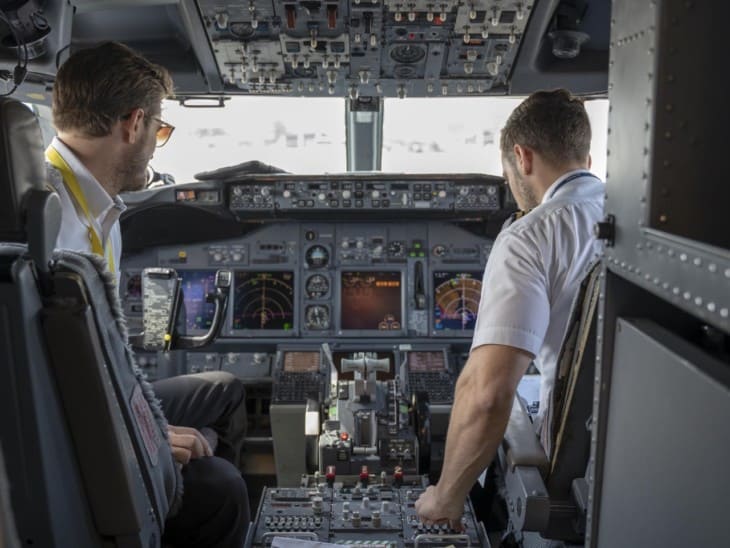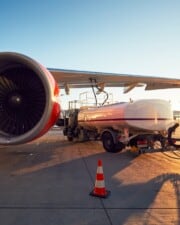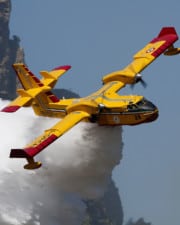In the early days of aviation, string was used to move different surfaces, before a more harder-wearing hydraulic system was developed. A Fly By Wire system is used in almost every commercial airliner today, allowing them to take off and land smoothly despite strong wind gusts or other environmental conditions.
As the name would suggest, fly by wire is a control system whereby flight control surfaces are controlled by electric systems. These wire-based systems take electrical inputs from the cockpit through thousands of miles of wires to make control systems respond to the pilot’s input in a matter of seconds.
What is Fly By Wire?
Fly by wire (FBW) is a flight control system that replaces hydraulic linkages between the pilot’s controls and the aircraft’s control surfaces with electronic systems.
In this system when the pilot manipulates the control inputs such as the control stick or yoke those movements are converted into signals by sensors.
These electronic signals are then transmitted to a computer or flight control system, which interprets the pilots commands and adjusts the position of the control surfaces accordingly.
For instance if the pilot pushes the control stick forward sensors detect this movement. This send signals to the flight control computer. The computer then adjusts the elevators on the aircraft’s tail to move causing the aircraft’s nose to pitch down.
Likewise if the pilot turns the control stick to the left it adjusts components on wings to roll the aircraft towards that direction.
In essence fly by wire replaces connections with ones enabling more precise and adaptable control over an aircraft’s movements. It is a technology utilized in airplanes, for flight control purposes and contributes towards enhanced handling, safety measures and overall performance.
Who Invented Fly By Wire?
Fly by wire technology is the result of efforts by engineers and researchers spanning several decades rather than being credited to a single inventor. Its development occurred gradually as electronic and computer technologies advanced and became more reliable.
However there are milestones and individuals who played roles in its evolution:
- Sir George Dowty: He is often acknowledged for pioneering the concept of fly by wire during the 1930s through his experimentation with operated flight control systems.
- NASA: Extensive research carried out by NASA during the 1950s and 1960s made contributions to fly by wire technology. The advancements in computers and electronic sensors during this period facilitated practical implementation of fly by wire systems.
- Aerospatiale: This French aerospace manufacturer gained recognition for their work on fly by wire systems throughout the 1960s and 1970s. They successfully integrated fly by wire technology into the Concorde airliner.
- Airbus; Airbus emerged as one of the pioneers in aviation that extensively incorporated fly by wire technology into their aircraft. The Airbus A320, introduced in 1988 stood as one of the airliners equipped with a comprehensive fly by wire flight control system.
What Was The First Fly By Wire Aircraft?
Although there were several aircraft that had FWB technology before – from the Tupolev ANT-20, to the Avro Canada CF-105 Arrow, to a modified Boeing B-47E Stratojet – the first production aircraft with modern FWB technology was the Concorde.
Developed jointly by Aerospatiale and British Aircraft Corporation (BAC), the Concorde required fly by wire technology to cope with the supersonic speeds (and the heat and stress that stressed on the wings and tail) the Concorde flew at.
The use of fly by wire on the Concorde proved to the industry that if it could handle the rigors of flying supersonic with 120 passengers, it could be used on other aircraft too. Following Concorde’s introduction, most commercial aircraft became fly by wire.
How Does Fly By Wire Work?
On the most basic level, fly by wire works to replace hydraulic systems previously used to control aircraft in a very simple seven-step process:
- Pilot Input: When the pilot moves the control stick, yoke, or pedals, these physical inputs are converted into electronic signals using sensors. For example, sensors measure the position and force applied to the control inputs.
- Signal Processing: These electronic signals are then processed by a flight control computer or a series of computers. These computers interpret the pilot’s input and calculate the appropriate control surface movements needed to achieve the desired aircraft response.
- Control Surface Actuation: The flight control computer sends commands to actuators, which are often electric motors or hydraulic systems, depending on the aircraft. These actuators physically move the aircraft’s control surfaces, such as ailerons, elevators, and rudder.
- Feedback Loop: FBW systems often include feedback mechanisms. Sensors on the control surfaces continuously monitor their positions and feed this information back to the flight control computer. This feedback loop allows the computer to ensure that the control surfaces are in the desired positions and that the aircraft is responding as expected.
- Control Laws: The flight control computer uses specific control laws or algorithms to determine how to move the control surfaces based on the pilot’s input and the aircraft’s current state (speed, altitude, attitude, etc.). These control laws can be highly sophisticated and are designed to optimize the aircraft’s performance, stability, and safety.
- Safety and Redundancy: FBW systems often incorporate redundancy for safety. Multiple sensors, computers, and control surface actuators may be used, and the system can automatically switch to backup components if a failure is detected. This redundancy helps ensure that the aircraft remains controllable even in the event of a system malfunction.
- Modes and Features: FBW systems can have different modes and features, such as envelope protection, which prevents the aircraft from exceeding certain limits (e.g., stall or overspeed conditions). These features enhance safety and handling characteristics.
Does Fly By Wire Use Hydraulics?
Fly by wire (FBW) systems primarily utilize electronic components to transmit and interpret control inputs enabling manipulation of an aircraft’s control surfaces. Unlike systems these FBW systems do not rely on hydraulics for direct control of the surfaces.
However in cases aircraft equipped with FBW systems may incorporate systems to indirectly actuate the control surfaces.
In situations the FBW system generates signals that are then sent to hydraulic actuators, which subsequently move the control surfaces. This configuration is often referred to as a “fly by wire, with backup” system.
Can Fly By Wire Fail?
Yes, fly-by-wire (FBW) systems can fail, just like any other electronic or mechanical systems. Failures in FBW systems can occur due to various reasons, including:
- Electronic Malfunctions: Faulty sensors, wiring issues, or computer failures can disrupt the FBW system’s operation.
- Software Glitches: Errors or bugs in the software that controls the FBW system can lead to malfunctions.
- Power Failures: A loss of electrical power can render the FBW system inoperative.
- Component Failures: Failures in critical components like actuators or control surfaces can impact the FBW system’s performance.
- Environmental Factors: Extreme weather conditions or exposure to electromagnetic interference can affect the system.
- Human Error: Incorrect inputs or actions by the pilot or maintenance personnel can lead to FBW system failures.
To mitigate the risks associated with FBW failures, modern aircraft with FBW systems typically incorporate redundancy, backup systems, and extensive testing to ensure the system’s reliability and safety.
Pilots also receive training on how to handle FBW failures and switch to backup or manual control modes when necessary. Despite these precautions, FBW systems, like any technology, are not immune to failures, but they are designed to be highly reliable and safe.
Does Fly By Wire Work Without Power?
No, a fly by wire (FBW) system cannot operate without power. The functionality of FBW heavily depends on components that require energy to function properly. In the event of a failure backup systems may offer control options but cannot fully replicate the capabilities of FBW.
Are All Airbus Planes Fly By Wire?
Airbus – as the main successor of Aerospatiale – has been a proponent of fly by wire technology since its founding. Indeed, every commercial aircraft built by Airbus since the introduction of the A320 family back in 1987 has had FWB incorporated into its design.
Does Boeing Use Fly By Wire?
As Airbus’s main competitor, Boeing has a long history of incorporating FWB technology in their own aircraft. Indeed, most of their new models – including the 777 and 787 – have incorporated fly by wire technology in their designs.
Why Doesn’t The Boeing 737 Have Fly By Wire?
The 737, along with the cargo 767s, are some of the few commercial aircraft still in production that do not have fly by wire for one simple reason: cost.
Both the 737 and 767 were originally certified before commercial FWB technology was the norm. To incorporate FWB technology into the aircraft’s cockpit would require not only an extensive redesign, but an equally extensive recertification process.
For Boeing, it makes little sense to spend the billions of dollars this would cost to get the 737 and/or 767 recertified as the sales of such an aircraft would likely never allow them to break even.
Are Helicopters Fly By Wire?
Helicopters mainly utilize hydraulic controls. Although certain advanced helicopter models incorporate fly by wire systems to assist with rotor control and stability enhancement, integrated fly by wire systems are not widespread, in the realm of helicopters. The level of fly by wire integration can differ across helicopter models.
Are Fighter Jets Fly By Wire?
Yes many modern fighter jets are equipped with fly by wire systems. Fly by wire technology is commonly utilized in fighter aircraft to enhance their agility, responsiveness and overall flight performance. These systems enable control of the aircraft during high speed maneuvers and combat scenarios.
The incorporation of FBW in fighter jets has become a practice in military aviation resulting in improved maneuverability and combat capabilities.
It enables flight control laws that can optimize the aircraft’s performance across flight regimes and dynamically adapt to changing conditions during combat engagements.
What’s the Difference Between Fly By Wire And Autopilot?
Fly by wire (FBW) and autopilot are two systems utilized in aircraft each serving its purpose and function.
Fly by wire (FBW) acts as a flight control system that electronically translates the pilots inputs, such as movements of the control stick or yoke into adjustments of the aircrafts control surfaces like elevators, ailerons and rudder.
This system improves the aircrafts handling characteristics, responsiveness and safety. However it still necessitates input and supervision from the pilot throughout the flight.
On the other hand, autopilot serves as a system designed to automate specific aspects of flight primarily related to navigation and stability. It can manage the aircrafts heading, altitude, airspeed and other parameters without intervention from the pilot.
Autopilot systems are often implemented to reduce pilot workload and maintain flight parameters during phases of flight such as cruising.
The input source for FBW relies on physical control inputs, from the pilot while autopilot systems can be programmed with flight parameters and waypoints by receiving inputs from navigation systems and sensors.
During the flight the Fly By Wire (FBW) system remains active. Promptly responds to the pilots instructions ensuring control of the aircraft. On the other hand when particular flight modes are desired, during stable flight phases the pilot engages the autopilot.
Once engaged the autopilot system independently handles flight control tasks. Still needs supervision and monitoring from the pilot.
What Are The Advantages of Fly By Wire?
Fly-by-wire (FBW) technology offers several advantages in aircraft design and operation, contributing to improved safety, efficiency, and performance. Some of the key advantages of FBW systems include:
Enhanced Precision
FBW systems provide precise and predictable control of the aircraft, allowing for smoother and more accurate maneuvers. This is particularly valuable in critical flight phases, such as takeoff, landing, and aerial refueling.
Reduced Pilot Workload
FBW systems can automatically adjust the control surfaces and stabilize the aircraft, reducing the cognitive and physical workload on the pilot. This is especially important in modern high-performance aircraft with complex flight envelopes.
Improved Safety
FBW systems can incorporate envelope protection features that prevent the aircraft from entering dangerous flight regimes, such as stalls or overspeed conditions. These safety measures help reduce the risk of accidents caused by pilot error.
Optimized Flight Control Laws
FBW systems allow for the implementation of custom control laws that can be tailored to optimize the aircraft’s handling characteristics and performance in various flight conditions.
Redundancy and Reliability
FBW systems often incorporate redundancy with multiple sensors and computers, enhancing reliability. If a component fails, the system can switch to backup components, reducing the likelihood of catastrophic failures.
Weight Reduction
FBW systems can be lighter than traditional mechanical or hydraulic control systems since they replace many of the heavy mechanical linkages with lightweight electronic components.
Adaptability
FBW systems can be programmed to adapt to different mission profiles and aircraft configurations, making them versatile for various military and civilian applications.
Maintenance Benefits
FBW systems may require less maintenance than traditional systems since they have fewer moving parts and are less susceptible to wear and tear.
Improved Handling Characteristics
FBW technology can enhance an aircraft’s stability and maneuverability, making it more agile and capable of performing precise maneuvers.
Reduced Pilot Training Time
FBW systems can simplify aircraft control and handling, potentially reducing the training time required for pilots to become proficient in flying the aircraft.
What Are The Disadvantages of Fly By Wire?
While fly by wire (FBW) technology offers advantages it also presents disadvantages and challenges:
Complexity and Cost
Implementing FBW systems can be both complex and expensive involving development and ongoing maintenance costs. The advanced electronic components and redundancy mechanisms can drive up manufacturing and upkeep expenses.
Dependence on Electrical Power
FBW systems rely on power. In the event of a failure the FBW system may become inoperative necessitating the use of backup systems or manual control.
Vulnerability to Cyber Attacks
As FBW systems become more connected and reliant on technology they can be vulnerable to cyberattacks. Safeguarding these systems from cyber threats is an increasing concern.
Limited Tactile Feedback
Some pilots argue that FBW systems may lack the tactile feedback that mechanical systems provide. This absence of “feel” can make it more challenging for pilots to assess the aircraft’s performance in flight conditions.
Reliance on Sensors
FBW systems heavily depend on sensor data. Malfunctioning sensors or inaccurate data can result in control inputs and hazardous situations.
Potential Decay in Pilot Skills
In aircraft with automated FBW systems pilots may become overly reliant on automation. This overreliance could lead to a decline in piloting skills. This can result in pilots losing their skills if they do not receive training in controlling the flight.
Susceptibility to Software Problems
Like any software based system, fly by wire (FBW) systems can be vulnerable to software errors or malfunctions that might impact the airplanes performance.
Resistance to Change
Some pilots, particularly those with extensive experience in older aircraft with mechanical or hydraulic controls, may be resistant to transitioning to FBW systems and may require retraining and adaptation.
Maintenance Complexity
While FBW systems can reduce the need for some maintenance tasks associated with mechanical systems, they introduce new maintenance requirements related to electronics and software.
Weight and Fuel Consumption
While FBW systems can reduce weight compared to mechanical linkages, the added electronic components and redundancy mechanisms can offset weight savings. Additionally, the electrical power required for FBW systems can contribute to increased fuel consumption.
Is Fly By Wire Better?
When compared to the hydraulic systems previously used to control an aircraft’s control surfaces, fly by wire is certainly an improvement owing to its improved safety, maintenance reductions and overall reliability.
However, whether it can truly be classed as “better” depends on the aircraft in question.
On an aircraft that has been designed specifically to be controlled by FWB, it is certainly better than the alternative hydraulic system.
However, on hydraulic-controlled aircraft, some, like the 737 and 767 could certainly benefit from such systems (even if not economically viable), whilst it’d likely raise more issues than it’d solve if retrofitted on an older aircraft, for example, one from the pre-Jet Age.
Related Posts














